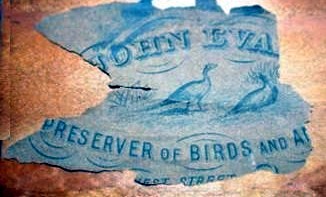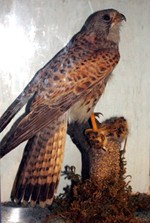|
John Evans
1817-1899

Fragment of a John Evans trade label
One of the most prominent
taxidermists working in England during Victorian times was John Evans who
established an international reputation for the preservation of rare birds
and exotic animals during the latter half of the 19th century.
His clients included many famous people from among the titled and landed gentry,
stately homes such as Burghley House, near Stamford, and Grimsthorpe
Castle, near Bourne, and army officers serving in India who often sent
home the skins of animals, including a tiger and a panther, for his
attention.
John was born at Heckington, Lincolnshire, in 1817, the son of a
carpenter, William Evans, who eventually moved to Bourne. After a spell in
his father's business, first as a joiner and then as a timber merchant's
clerk, his interest in natural history prompted him to take up taxidermy
and by 1850 he was working from the family's shop premises in West Street,
Bourne.
The first recorded example of his work comes from the summer of 1850 when
a flight of curlews flew over Bourne and four of them were shot by a
groundkeeper employed by John Walker Hardwicke, a farmer and grazier, of
Dyke. After that, the variety of species John Evans was dealing with is
illustrated by the various newspaper reports which gave some prominence to
his work.
The list of rare and uncommon species continued and in the years that
followed he preserved a red-backed shrike or butcher bird that had been
shot at Bourne in 1864 together with a splendid specimen of a black and
white blackbird and a cream-coloured house sparrow.
Others included two peregrine falcons, one hen harrier, one honey buzzard,
one merlin, thirteen kingfishers, a grey shrike, two Bohemian waxwings, an
all-white missel thrush, two stormy petrels, three chough, a Manx
shearwater, a puffin, two Canada geese each weighing 12 lb. and measuring four feet long from bill
to tail and six feet two inches expanse of wings,
and a fine specimen of bittern that had been shot in Bourne Fen, an adult
male bird in splendid plumage measuring three feet seven inches from toe
to bill and four feet across the wings.
His reputation soon spread countrywide and he was frequently called on to
preserve rare animals and birds from many parts of the British Isles,
usually displaying them when finished in the front window of his shop for
passers-by to inspect before sending them off to his customers.
 |
John Evans must have produced hundreds of
specimens of stuffed birds during his lifetime yet surviving
examples are rare such as this kestrel that can be found in
Peterborough museum. |
John married Elizabeth Blay, a servant girl, in 1843 and they had two
daughters, Betsy (1844) and Mary (1846). Mrs Evans died at Bourne on 2nd
March 1886, aged 72, but he continued to work with the help of a manager,
William Cullingford, although by the end of his career, protest groups
were already springing up to prevent such practices, eventually leading to
the formation of the Royal Society for the Protection of Birds in 1899.
Nevertheless, he continued working until 1898 when he moved to Ely to live
with relatives where he died in 1899, aged 83.
After the death of John Evans, Cullingford took over the business in
Bourne but he was troubled by ill health and unable to continue at
West Street and by 1905, the premises had closed down. He died two years
later in 1907, aged 56.
In 1872, Mary Evans married Joseph Minett, a grocer and draper, from
Hawkesbury, Gloucestershire, and they had six children.
Betsy Evans became a schoolmistress and in 1877, she married William
Cullingford's brother, Joseph. She died in 1873, aged 30, and in 1877, he
married again, this time to Elizabeth Ann Bishop.
Although trained as a painter, Joseph had
always been interested in natural history, no doubt influenced by the work
of John Evans and his brother, and by 1881 he had moved to Durham where he
was appointed first as sub-curator at the Palace Green Museum in the
Castle Precincts, later becoming curator and taxidermist (birds) at the
University Museum. By 1911, he had retired and returned to Ely where he
died in 1921, aged 76.
Ironically, the work of Joseph Collingwood
is regarded today as the finest taxidermy from the period and is eagerly
sought by collectors. Few examples by John Evans have survived although
some are believed to be in private homes in the area and a
preserved kestrel can be found in the natural history section at
Peterborough Museum.
REVISED JANUARY 2014
See also
Birds of Bourne

Go to:
Main Index Villages
Index
|

